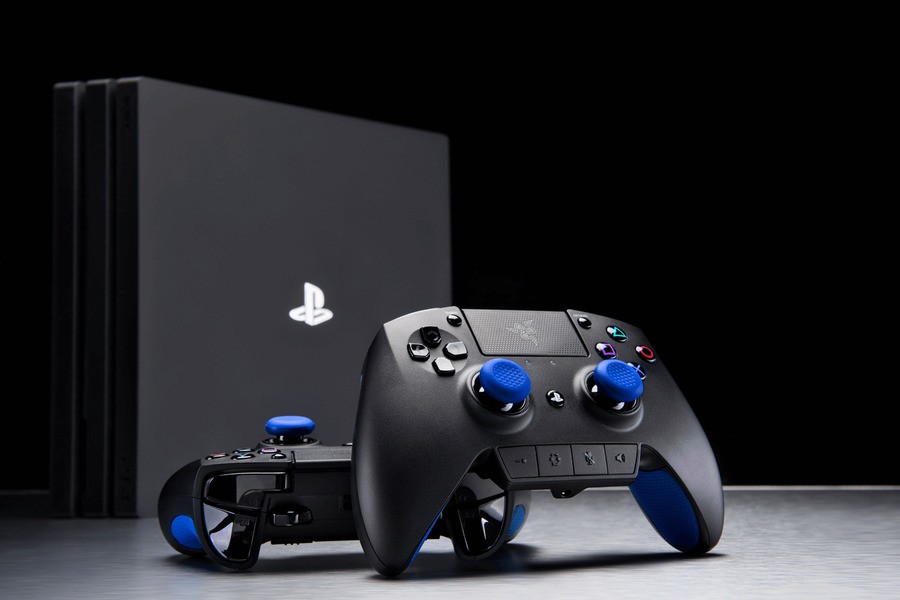
Officially licensed by Sony, the Razer Raiju is one of the PlayStation 4's 'Elite' controllers – the other being the Nacon Revolution. At the time of writing, the Raiju retails for around £150, so it's safe to say that it's a premium piece of gadgetry. In order to pen this review, we spent around 60 hours with the Raiju, playing through a whole library of different PS4 titles.
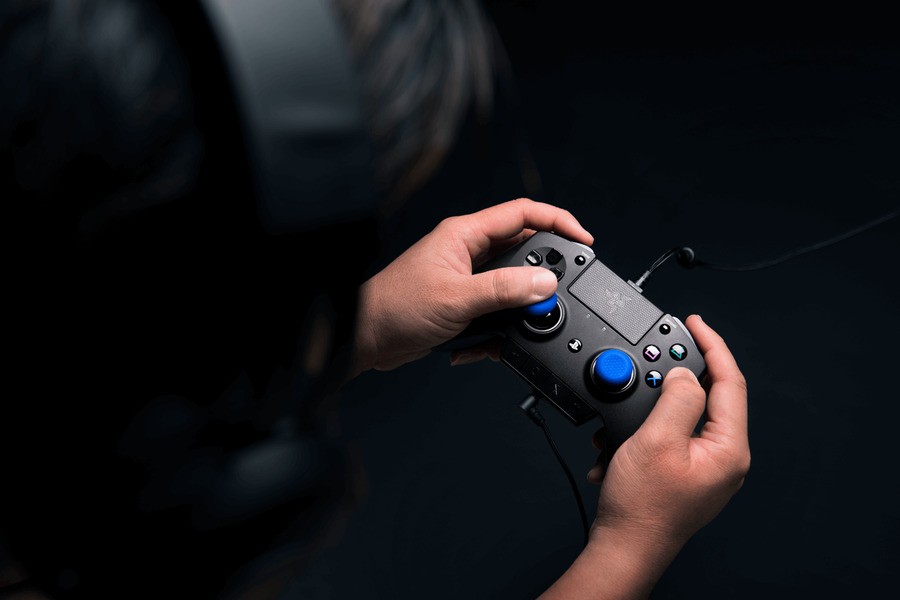
Build quality
To start with, let's talk about the general build quality of the Raiju. For its price, you'd expect high standards in this department, and fortunately, that's exactly what you get. One of the first things you'll notice is that the pad has a decent heft to it. The Raiju is slightly heavier than a standard DualShock 4, but that extra weight undoubtedly gives it a more expensive feel.
The matte plastic of the controller's casing also shares that premium feel. It's sturdy stuff that has a nice texture to it, while the buttons and triggers opt for a glossy, smooth finish. There's a nice contrast here, and going by touch alone, the differences in material help separate the casing from the buttons. The rubber grips that line the undersides of the pad are also of a high quality.
Comfort and grip
We've already mentioned the increased weight of the Raiju, and this helps the controller sit a little better in your hands. The 'handles' of the Raiju aren't quite as defined as those you'll find on a regular DualShock 4, but they feature more angled undersides, complete with the aforementioned rubber grips. Once we had grown accustomed to the difference in shape, we found the Raiju to be incredibly comfortable, with the handles being a snug fit within our palms and our index fingers naturally resting on the triggers.
After extended gaming sessions, we felt little to no discomfort, whereas with the normal DualShock 4, we often get slight aches in our index fingers, specifically when playing shooters for hours at a time.
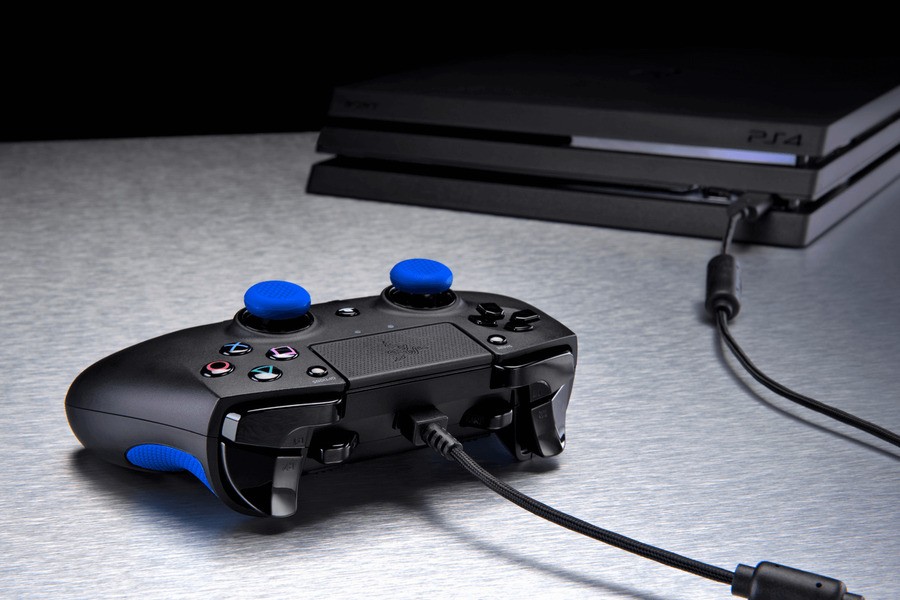
Face buttons
As with the standard DualShock 4, the Raiju boasts four face buttons on the right of the controller: X, square, triangle, and circle. However, the big difference here is that the Raiju's buttons don't have as much depth. In other words, when you push them, there's almost no travel distance. Instead, they 'click', much like the right and left buttons on a mouse. At first it can seem a little strange – especially if you're used to using a DualShock 4 – but it isn't long before you start appreciating their responsiveness.
Indeed, responsiveness is the keyword here. The DualShock 4's face buttons certainly get the job done, but with the Raiju, you can simply glide your thumb across any of the four buttons and have it click almost immediately, which is handy for actions like reloading in a shooter, or when you need to quickly input commands in a fighting game.
The clicking noise itself isn't exactly loud, but it is noticeable at first. That said, it didn't take us long to tune it out, and we even came to appreciate the audible feedback.
Analog sticks
Unlike the Nacon Revolution, the Razer Raiju chooses to stay loyal to PlayStation's traditional controller layout, keeping the analog sticks opposite one another on the bottom half of the pad. Obviously, this is an inherent plus if you're a fan of Sony's trademark design.
After just a few minutes of play, it's clear that the Raiju's sticks are easier to move than the DualShock 4's. Here, there's next to no stiffness, resulting in especially smooth stick movement, and when either stick is released, they spring back into their neutral position very quickly. Again, the difference in sensitivity may take some time to get used to, but the more fluid feel of the Raiju's sticks does, in our experience, translate well into games that require precise movement.
By default, the Raiju's sticks come with two optional rubber caps placed over them. These little blue additions offer extra grip for your thumbs, but we actually prefer to play without them, purely because we feel that they make the sticks just a tiny bit too tall. Of course, our preference largely comes down to the length of our thumbs – those of you with larger hands may find that the caps prove more comfortable. Either way, we had no problems with the regular sticks. In fact, we'd go as far to say that we found them far less slippery than the DualShock 4's – not once have our thumbs struggled to stay on top of them.
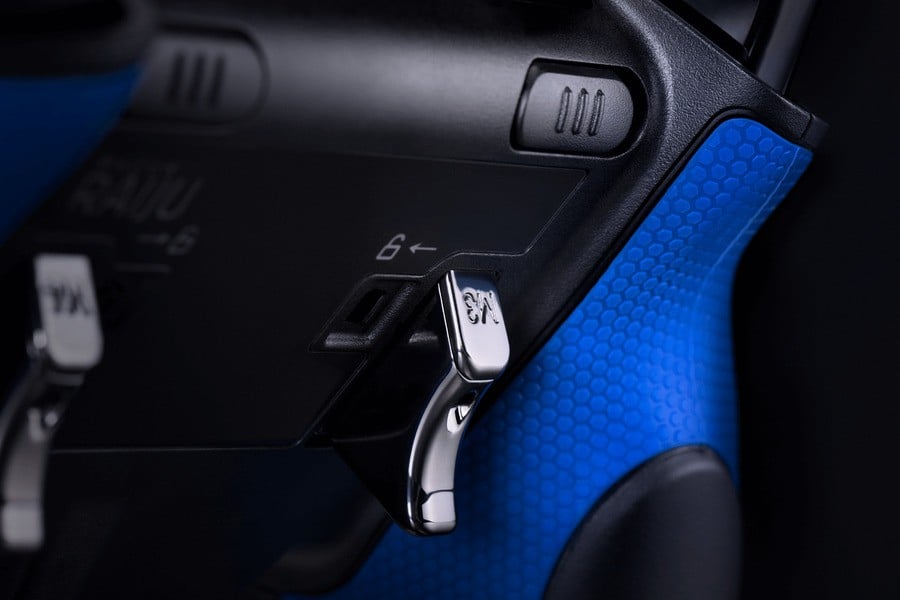
Triggers
This is where the Raiju gets interesting. Built with competitive play in mind, Razer has slapped four extra triggers on its controller – two of which can be removed.
First off, though, let's go over the familiar R1, R2, L1, and L2 triggers. R1 and L1 are both lengthy buttons that click when pushed. They also curve with the outside of the controller, meaning that they can be a bit difficult to find in the heat of the moment – especially if you're used to the DualShock 4's smaller, more defined buttons. As far as we're concerned, R1 and L1 are probably the weakest aspects of the Raiju.
Fortunately, R2 and L2 fare much better. Both triggers push down incredibly smoothly, and spring back into place with less force than the DualShock 4's, resulting in triggers that simply feel easier to use. What's more, the Raiju boasts two sliding locks on its back that can alter the travel distance of the R2 and L2 triggers. When the locks are pushed in, the triggers lose the majority of their depth, meaning that you can tap them rather than push them all the way in. As you'd expect, this is a great feature when it comes to playing shooters that boast quick, twitchy gunplay. It's also nice to have around when playing titles that map specific actions to R2 and L2 as well.
On the right of L2 and the left of R2 are two extra triggers. Inscribed with M1 and M2, these clicky little angles act as a second pair of R1 and L1 buttons by default. Their close proximity to R2 and L2 make these extras a surprisingly effective alternative to the Raiju's disappointing R1 and L1 offerings, since they should be within reaching distance of your index fingers when they're resting over the triggers. M1 and M2 can even function as different buttons of your choosing thanks to the controller's built-in remapping system.
Last but not least, we have the two triggers that sit on the underside of the Raiju, dubbed M3 and M4. Like most of the buttons on this thing, these two click when pressed, and as is the case with the M1 and M2 buttons, they can be remapped to suit your needs. It can certainly seem weird to reach out and feel triggers with your middle or ring fingers, but if you do find them distracting, you're able to remove them with the help of a small screwdriver that's included with the controller. They're very easy to reattach, too.
Directional pad
The Raiju's directional pad is less of a pad and more of a... Well, it's four separate buttons. Instead of being one big button that rests underneath the controller's casing with four ridges poking out, here we have four entirely independent inputs that are spaced further apart.
Each of the four directional buttons have quite a lot of depth to them when pushed, and are reasonably stiff, unlike the Raiju's other face buttons. They almost feel like they belong to a different controller, but there are some advantages to this separated design. For starters, it means that directional inputs are generally more precise – you won't find yourself pressing two directions at the same time by accident when pushing your thumb over the pad. On top of that, they offer better physical feedback due to not being as spongy as the d-pad found on the DualShock 4.
However, they're definitely harder to press. Their stiffness means that you can't just tap them – you need to properly push them in, which can seem like an unnecessary exercise in effort when you quickly want to switch weapons or simply navigate a menu. If the Raiju's directional buttons were clicky like the rest of the controller, we'd likely have no issue, but as it stands, our opinion is somewhat divided.
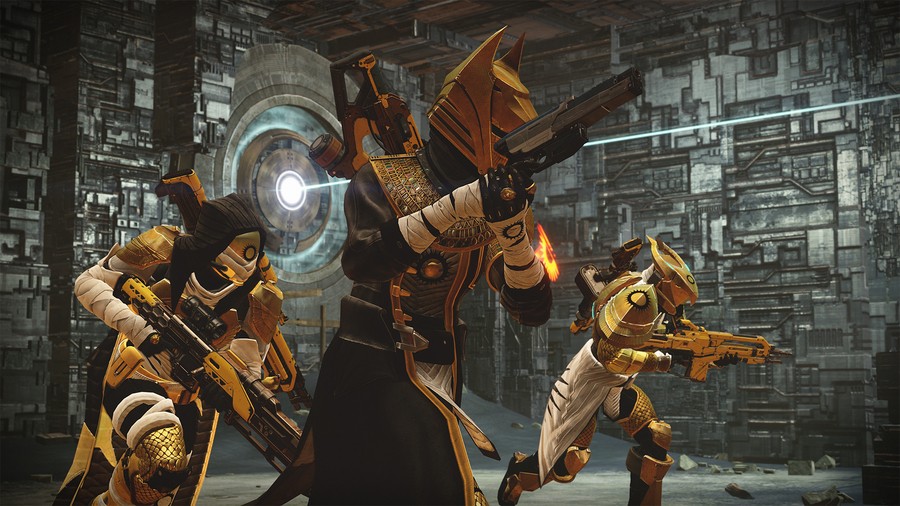
Does the Razer Raiju make you better at shooters?
For the most part, we were left very impressed with the Raiju's performance in shooting games. Not only does it offer more responsive controls thanks to slicker analog sticks and faster triggers, but it also allows for thoughtful player customisation.
For example, in Destiny, rather than having to take our thumb off the right analog stick in order to reload our weapon by pressing square, we could simply map reload to one of the four extra triggers. This allowed us to keep our sights on our enemies even when out of the action. A relatively small detail, but one of many that competitive players may find very useful.
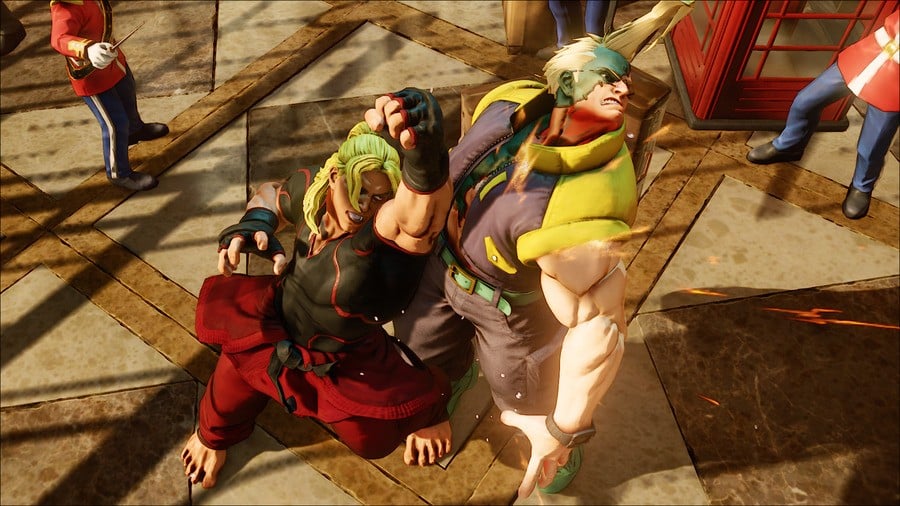
Does the Razer Raiju make you better at fighting games?
The Raiju is a little hit and miss when it comes to fighting games. The responsive face buttons and triggers let us string together attacks that much easier in titles such as Street Fighter V and BlazBlue: Central Fiction, but the directional pad certainly took some time to get used to. Because the directional buttons are farther apart, we sometimes found it difficult to input circular motions, which obviously play a large role in pulling off special moves in many fighters. Similarly, because of their stiffness, we also found movement to be a touch more strenuous on our thumb.
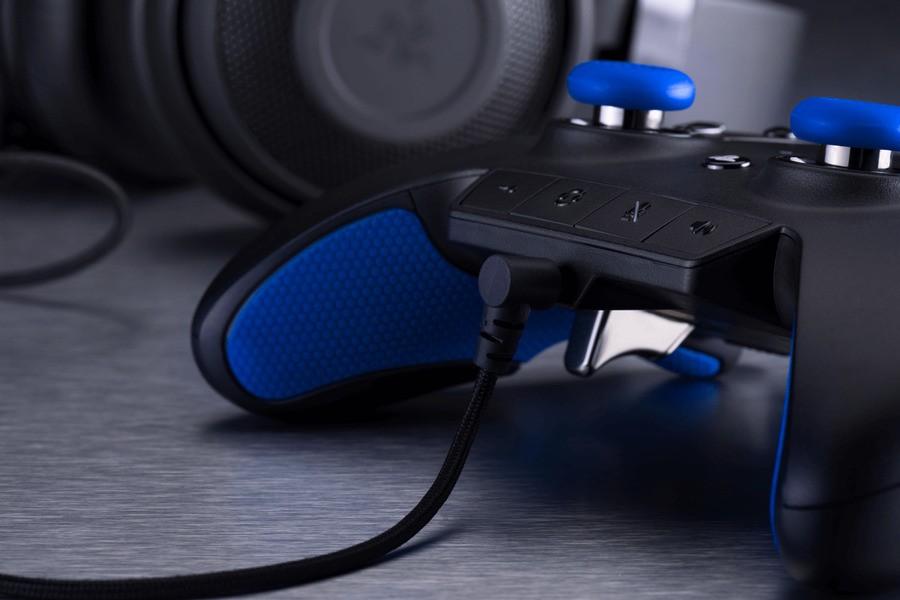
Other bits and pieces you should know
Before we wrap this review up, we just want to take a moment to note a few bits and pieces that potential buyers should be aware of.
First off, the Razer Raiju only functions as a wired controller; you need to have it plugged into your PS4 in order to use it. What's more, it isn't compatible with your regular DualShock 4 USB cables. Instead, you have to use the USB cable that comes packaged with the controller. Thankfully, said cable is high quality, featuring a strong, braided wire that's far lengthier than a standard DualShock 4 cable.
Is having a wired-only controller inconvenient? Of course, but we can't see it being an issue unless you tend to sit a mile away from your PS4. Indeed, a bigger annoyance for us is that the Raiju's PlayStation button is unable to turn the PS4 on. You'll need to get up and manually switch your console on before using the controller.
Below the analog sticks sit four extra buttons. The first two are used for remapping buttons – a feature which is very adequately explained in the controller's instruction manual – and the other two can be used to control chat audio. The quick mute button is an especially handy extra.
Lastly, it's worth mentioning that the Raiju retains all of the DualShock 4's current-gen features. The Share button, touchpad, and options button are all in place, with the touchpad in particular being an improvement over the original due to a more - you guessed it - responsive, less spongy feel. The Raiju also keeps the headphone jack at the bottom of the controller.

Conclusion
It may not be Sony's own design, but the Razer Raiju is an impressive PS4 controller all the same. We find ourselves preferring its responsive face buttons, smooth analog sticks, and slick triggers, even if its directional pad could and probably should have been better implemented. Its built-in remapping system is perfect for experimentation and will no doubt see use from competitive players, and its build quality is great across the board.
As far as a 'pro' PS4 controller goes, it's hard to really fault the Raiju. In many ways, we think that it's a definite improvement over the DualShock 4, but on the market for £150, you'll need to ask yourself just how eager you are to step up your game.
Are you tempted by the Razer Raiju? Do you already own one? Let us know what you think of this premium product in the comments section below.





Comments 55
If the rubber nubs last longer than the DS4, that's what matters.
If anyone has any specific questions, just ask and I'll do my best to give you an answer.
@Totaldude911 Definitely, the rubber on these analog sticks is way, way firmer than the rubber on the DualShock 4's.
What bloody century are we living in???
I would have given this a serious look at around £80 especially with this glowing review. £150 at half the cost of a ps4 pro is bit much in my opinion.
Agreed with mcnoisy. Too expensive for what you get. Having said that, I would understand a highly competitive FPS player considering the purchase as it might give them that slight advantage.
Spent £300 on headphones for better sound but not just for console but also music. I am not good at shooters anyway so no controller is ever going to change that. There are other devices that allow yo to map controllers which you can program yourself and they cost a lot less than this controller and you can still use your original PS4 conroller if anything I would go for one of those.
I didn't see it addressed in the article, maybe I missed it, but that thing looks like a modded X1 controller to me. Like, nearly identical.
Razer stuff doesn't last two minutes and is overpriced cheap crap. I'd never ever buy anything from them again.
Will you be reviewing the nacon one? I won't be buying either of them, just wondering.
I just want dualshock 4 with bigger battery
What exactly is the cord length? I don't sit a mile away but I also don't like to play with my face on the tv.
@dryrain @themcnoisy If anything this just shows what great value consoles are in general.. Ps4, Pro and Xbox 1 all offer great value for money.
@ZAKtheRIPPER It's 3 metres / 10 feet. A lot bigger than the standard DualShock 4 cable and should be long enough for the vast majority of gaming setups unless you happen to live in a mansion and have a 90 inch TV.
@Dan_ozzzy189 Not true, I have Razer Naga mouse that I have well used for the past 6 years. I guess if you don't take care of your stuff then yeah.
@ShogunRok Maybe i have a good batch mine controllers are still fine after a year.
Controller looks great but £150 probably €170 here in the Netherlands it is to much.
Overpriced IMO.
I'd like to know if you sensed any, even slight, limitation brought about by the device being wired. I wonder if perhaps there was a need to compensate for that possible little niggle of constraint in the back of the mind?
@Dan_ozzzy189 I have a 3 year old pair of Razer Bahamut headphones that have worked fantastic. The key to any PC hardware company is that buying cheap, made-for-walmart components and/or not taking good care of them leads to them breaking more often than not.
My brother and I bought the same mouse in 2014 and I'm still using mine while he's gone through 3. The difference is that I don't slam it around, drop it, and I keep it clean.
i use L1/R1 for shooting in all games (i'll even use the accessibility option to remap L2/R2 to L1/R1 if i really have to), so the fact those triggers are a weakness has already lost my interest.
btw: i have still have the original launch DS4 from 2013, and have used textured thumb grips over the top of the analogue sticks since then. as a result, the rubber is in as good condition as the day i opened the box.
My DS4 is fine, thanks... and I think the price of those is a little much. No way would I pay that kind of money for a controller, even if it does have a few more buttons.
@nathanSF Not at all, I forgot the controller was actually wired for the most part. That said, I do sit quite close to my PS4 and TV - you might notice it if you sit several feet away and are used to being able to move your DualShock around completely freely.
I don't have any issues with the DS4, and £150 is a crazy price to pay for a console controller IMHO. Think I will give this a miss.
@ShogunRok "should be long enough for the vast majority of gaming setups unless you happen to live in a mansion and have a 90 inch TV."
Which, ironically, is the only demographic that'll be willing to nonchalantly part with £150 for this controller.
If it ever drops to $100 usd I'll pick one up. I love the idea of being able to jump and reload in shooters without having to take my thumbs off the right stick.
@ShogunRok will this make me less cack at Destiny?
It has nothing to do with not looking after my stuff. Rather frigging rude, my stuff is pristine. I had ping golf clubs ten years that I sold that were immaculate, same with my fishing gear, hifi, anything I pay hard earned money for. You've had a mouse that lasted a long time. Well done. I bought an xbox 360 razer pad for my son and it barely lasted 3 months before the buttons stuck and the right stick failed. Search the web, they have a bad rep for a reason. I totally get that some people have good experiences but you also have to accept that many people also have bad experiences, myself included. And whoever said as long as the rubber lasts longer than the Sony pad is all that matters is surely joking? Yes, I'll gladly pay & 150 for that privilege! NOT! A couple of butterfix toppers sorts that out for a few quid. Horses for courses but don't tell me I don't look after my stuff. OK?
@THRILLHOU Potentially. I mean, the ability to set extra buttons up to do different things could give you an advantage - but if you're bad at a game to begin with I don't think a better controller is going to help much!
Way to expensive and Razer out of all brands out there. I would much rather have a controller made by logitech.
@Kamikaze_Krunch I have Logitech G700s gaming mouse that I've been using for a few years now. I love that thing. I really haven't used Razer, but Logitech is known for premium build quality. I too would buy a Logitech PS4 controller.
150 is daft money, a SCUF as far as I'm aware is practically hand made and costs slightly less for a standard model. I'd like one but at 150, no chance. Quick mute though, excellent.
@Dan_ozzzy189 You just said it has nothing to do with how you take care of your stuff, gave your golf clubs as an example, and then pointed to how a controller you gave to your son had problems after 3 months. I don't see the correlation. Clearly you don't like Razer, and that's ok, but stating all of their equipment is junk based on one failed product (in which you have no idea how it was treated since it wasn't yours) is something I would consider "frigging rude". Take a pill, sir.
For as good as this sounds, I think the interest in this controller proves that Sony is basically leaving money on the table by not doing its own line of 'Pro' controllers.
Like, sometimes you just need to accept the competition had a good idea and copy it.
Good review. I'm slightly more interested in one of these than I was before, but not for £150. There's clearly a market here if you hit the right price point.
Too expensive, there is a market for this stuff but not for over 99£
I've had several peripherals from Razer over the years. I can now say that they're overhyped mediocre products with poor quality control. I take care of my stuff (even keep the boxes in case I want to sell them a few years down the road and then they look still like new). But I had a Tournament Controller for the Xbox 360 fail on me (buttons got stuck) after only a few weeks, a keyboard and mouse combo have software issues due to driver problems and a headset emitting a constant humming sound when the mic was on.
No thanks. Not for that price.
@ShogunRok
Thanks. Yes, I do sit several feet from the TV. I always make sure the spare controller is charged.
I suspect the extra weight is probably unnecessary since it doesn't even have a battery inside it - and is there to give a physical 'weight' to the premium price they are asking. Has anyone taken one apart?
@RedMageLanakyn Looks like a modded DS4 to me.
@RedMageLanakyn perhaps I should have made it clear that I'm nearer to 50 than 40 and my son wasn't a snotty little toe rag with no respect for items that were bought for him with hard earned cash. Either way, the items I'd had experience with, razer controllers, both failed. They really need to improve the quality of their products but time will tell on this one.
The extra weight that the XB1 Elite has is in part down to more metal used in the construction. Even the thumbstick shafts are metal as is the circular hole they sit in to avoid wear and plastic dust. These thumbsticks are also customisable to add more length (great for more precise aiming/movement). The elite also can function wirelessly too and can store two different settings for its layout to switch between easily - You could have one setting for shooting combat and a different setting for vehicular action for example. All this for around £100 now. You can even have different intensities for the 4 rumble areas on each setting too.
I know the DS4 is a more 'expensive' controller to manufacture as it also incorporates a touch-pad but £150 seems very expensive. It would be as cheap to get a Scuf - cheaper if you have a DS4 to send in. Scuf offers everything this does (apart from sound options like the mute) as well as the option to have different length thumbsticks and more custom casing options too. It can also be used wirelessly - for those times when the microseconds of lag don't matter.
I really don't understand how they can justify this price point. Maybe Razer are having to pay Sony a licence to manufacture and added that on top, maybe have to pay more for certain parts (like the trackpad) as they are not buying in the same quantity as Sony. I would rather put my money towards a Scuf though than this as I feel its more customisable to me and looks better too.
Paid for mine a few day's ago, just waiting until Amazon is in stock and boom it's mine. I bought the Nacon Pro controller first (the cheaper on £90) but it sux tbh, returned it and now i'm trying this bad boy when it's in stock.
Scuff controllers are OK but they use the same battery as the Dumps4 and if your only willing to spend £100 on a scuf then the only added bonus you'll get is the paddle. You start asking for adaptable thumbstick's and start messing about with the trigger's and any of the other stuff the Razr has and you'll be lucky to pay under £150 for a scuf. And edited to say Scuf's return policy sux as well where as Razr's is top notch. a friend I play with every day spent £300 on a gaming keyboard (one that fit's the entire keyboard under one palm look's like a spaceship it's awsome) to go with his zym for his PS4 he's used a gaming keyboard and mouse for over a year now, and he wasn't happy with a button on it, all he had to do was show photographic evidence with the product number's etc visable that he had destroyed the item beyond sale or use and they mailed another to him within day's. And another edit to put that I only paid £140 for mine off Amazon, not in stock yet lol but a tenner's a tenner lol.
All I want is a better battery for the DS4 dammit. Is it too much to ask!?
With that D-pad, I won't even bother considering this controller.
PushSquare, you should make a comparison article about the best accessory controllers for PS4, and pay special attention to the D-pads.
Eh, Idk.
I'll stick with the DS4 and X1 controller for consoles.
Just got a chatpad for my X1 PC controller, and oh, just got a STEAM controller too. It's pretty cool actually. Perfect for games like Civilizarion
@moe88_ The shell itself i think is actually from an X1 controller, although it is obviously heavily modified since they added the touch pad and rearranged the analog sticks. The face buttons look the same, and those four buttons on the bottom are part of an X1 headphone plug-in.
As a left-hander, I've swapped my DS4 face buttons with the D-Pad buttons and mirrored the sticks and triggers using the 'Accessibility' options on my console, so I'm interested in the discrete function of the four seperate D-Pad buttons. The wider spacing is handy too. But the extra pressure required doesn't sound great.
When used as face-buttons like this, is the Razer D-Pad a better choice than the 'spongey' DS4 D-Pad? Or would the extra pressure be a hindrance? Are they easy to spam?
@KillerScene Using the Raiju's d-pad as the face buttons sounds difficult to me. They may function better than the DualShock 4's d-pad purely because they're separate buttons, but you wouldn't be able to hammer them as easily since they're so stiff. I don't think it'd be such a good idea.
I'm perfectly fine with the DS4. I would rather spend that money on games.
Yeah the standard DS4 works for me, I have 4 of them and there's always one charged ad ready to go. I sit next to a cable anyway, and that's 3-5 games worth right there. But if this is what you're after, more power to you! I've not owned an unofficial controller since the Mega Drive days
I have to say my biggest complaint has to be we can't use after market micro usb. I don't mind the cord in fact I always keep my controller plugged in but I don't think a 10 ft cord is long enough and I won't spend $150 to find that out, otherwise I'd have one already.
I wouldn't spend that much money on a controller that isn't wireless. Razer should know better, looks like they are up to the same crappy stuff as always. **yawn** next please as I will permanently ignore Razer from here on out.
Any decent PS4 keyboard/mouse for that amount of cash? Willing to give it a try for FPS games...
cool... so... where i buy?
@Dan_ozzzy189 i beg to differ ive had a razer keyboard for 10 years and worked fine and im a hard ass with my gear when it comes to online gaming and its never failed once touch wood so i think your suggesting this when infact if your buying the budget razer gear (sub 100 quid) then its usually a bit pants but the abover 100 quid gear is the dogs doo daas enough said really.
@Kamikaze_Krunch I don't believe any Pro controllers will be wireless due to the input lag.
Tap here to load 55 comments
Leave A Comment
Hold on there, you need to login to post a comment...